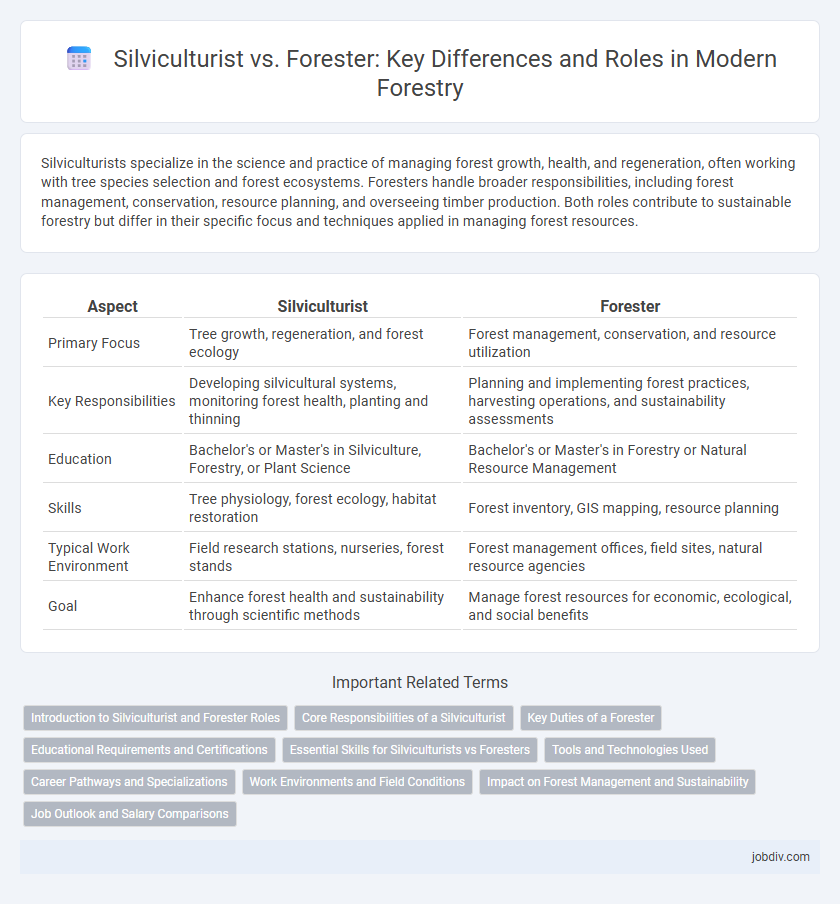Silviculturists specialize in the science and practice of managing forest growth, health, and regeneration, often working with tree species selection and forest ecosystems. Foresters handle broader responsibilities, including forest management, conservation, resource planning, and overseeing timber production. Both roles contribute to sustainable forestry but differ in their specific focus and techniques applied in managing forest resources.
Table of Comparison
| Aspect | Silviculturist | Forester |
|---|---|---|
| Primary Focus | Tree growth, regeneration, and forest ecology | Forest management, conservation, and resource utilization |
| Key Responsibilities | Developing silvicultural systems, monitoring forest health, planting and thinning | Planning and implementing forest practices, harvesting operations, and sustainability assessments |
| Education | Bachelor's or Master's in Silviculture, Forestry, or Plant Science | Bachelor's or Master's in Forestry or Natural Resource Management |
| Skills | Tree physiology, forest ecology, habitat restoration | Forest inventory, GIS mapping, resource planning |
| Typical Work Environment | Field research stations, nurseries, forest stands | Forest management offices, field sites, natural resource agencies |
| Goal | Enhance forest health and sustainability through scientific methods | Manage forest resources for economic, ecological, and social benefits |
Introduction to Silviculturist and Forester Roles
Silviculturists specialize in the science and art of controlling forest establishment, growth, composition, and quality to meet diverse needs and values, applying principles of ecology and biology to manage tree populations. Foresters focus on managing forests for economic, recreational, and conservation purposes, involving tasks such as timber harvesting, forest inventory, and land management planning. Both roles collaborate to ensure sustainable forest management, with silviculturists emphasizing vegetation management and foresters overseeing broader forest resource planning.
Core Responsibilities of a Silviculturist
Silviculturists specialize in managing forest growth, focusing on the regeneration, growth, composition, and health of forest stands through practices like planting, thinning, and controlled burns. Core responsibilities include developing silvicultural prescriptions, monitoring forest ecosystems, and implementing techniques to enhance timber production and biodiversity. Unlike foresters, who may handle broader resource management and policy enforcement, silviculturists concentrate on the scientific and practical aspects of forest stand development and sustainability.
Key Duties of a Forester
Foresters manage forest resources by planning and executing sustainable harvesting, monitoring tree health, and enforcing conservation policies to balance ecological and economic goals. They conduct field surveys, analyze forest data, and collaborate with landowners to develop management plans that promote reforestation and wildlife habitat preservation. Their work supports timber production, wildfire prevention, and ecosystem restoration, ensuring long-term forest sustainability.
Educational Requirements and Certifications
Silviculturists typically require advanced degrees in forestry or environmental science, often holding a master's or doctorate to specialize in forest growth and ecology management. Foresters usually possess a bachelor's degree in forestry or natural resources, with certifications such as the Certified Forester credential from the Society of American Foresters enhancing their professional standing. Both professions benefit from state-specific licenses and continuing education to ensure expertise in sustainable forest management practices.
Essential Skills for Silviculturists vs Foresters
Silviculturists require specialized knowledge in tree biology, growth patterns, and ecosystem management to design and implement effective forest regeneration strategies. Foresters focus on broader skills, including forest inventory analysis, resource planning, and timber harvesting techniques to manage and sustain forest resources. Both roles demand proficiency in GIS technology and environmental regulations but differ in their emphasis on ecological restoration versus operational management.
Tools and Technologies Used
Silviculturists primarily use tools such as growth measurement instruments, soil analysis kits, and remote sensing technology to monitor and manage tree development and forest regeneration. Foresters rely on Geographic Information Systems (GIS), Global Positioning Systems (GPS), and forest inventory software to plan harvests, map forest resources, and manage timber production efficiently. Both professionals utilize drones and LiDAR technology to assess forest health, but silviculturists focus more on ecological data while foresters emphasize resource management and operational logistics.
Career Pathways and Specializations
Silviculturists specialize in the cultivation and management of forest vegetation, focusing on tree regeneration, growth, and health, often requiring advanced knowledge in biology and ecology. Foresters manage overall forest resources, incorporating timber harvesting, conservation, and land use planning, with career paths ranging from government agencies to private industry roles. Both careers offer specializations such as urban forestry, fire management, or forest policy, but silviculturists tend to emphasize ecological research while foresters balance economic, environmental, and recreational objectives.
Work Environments and Field Conditions
Silviculturists typically work in research stations, nurseries, and forest management offices, focusing on tree cultivation techniques and forest regeneration in controlled environments. Foresters engage more directly with varied field conditions, overseeing forest conservation, timber harvesting, and ecosystem management across diverse terrains and weather patterns. Both professions require adaptability, but foresters experience greater exposure to remote and rugged landscapes.
Impact on Forest Management and Sustainability
Silviculturists specialize in the science of managing forest regeneration, growth, and health, directly influencing sustainable forestry practices by implementing techniques like selective cutting and reforestation to maintain ecosystem balance. Foresters oversee broader forest management operations, including resource inventory, policy enforcement, and land-use planning, ensuring long-term sustainability and economic viability. Both roles are crucial for integrating ecological principles with forest resource utilization to optimize conservation and productivity.
Job Outlook and Salary Comparisons
Silviculturists typically earn higher median salaries, ranging from $60,000 to $80,000 annually, compared to foresters who average between $50,000 and $70,000. Job outlook for silviculturists is projected to grow by 6% over the next decade, influenced by increasing demand for sustainable forest management and reforestation projects. Foresters face a steady employment growth rate of about 5%, supported by roles in forest conservation, wildfire prevention, and timber resource planning.
Silviculturist vs Forester Infographic

 jobdiv.com
jobdiv.com